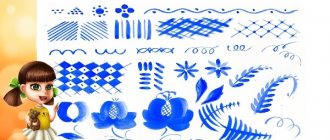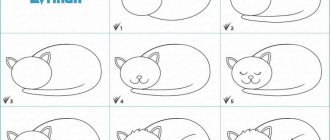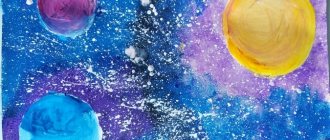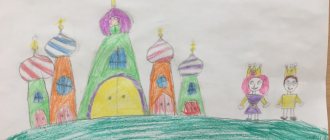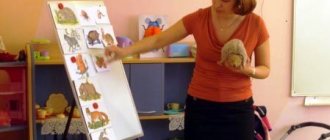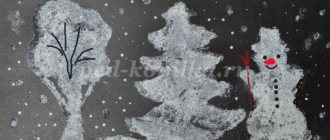Date: March 28, 2022 Author: Maria Skopina Category: For preschoolers
In the education and upbringing of children aged 6–7 years, the priority task is to prepare children for school. Each lesson is aimed at forming and consolidating those skills, as well as developing personal qualities that a future first-grader needs to study in elementary school.
Fine arts classes contribute to the comprehensive development of preschoolers: they meet the cognitive needs of children, help expand their vocabulary, and instill a sense of beauty. By drawing, children learn to predict and analyze actions, create a composition step by step, taking into account initial knowledge of perspective, perform various techniques with a pencil or brush, thereby preparing their hands for the most important process in first grade - mastering writing.
For the preparatory group, one of the most interesting topics for a drawing lesson will undoubtedly be “Birds,” where both migratory and domestic birds will be considered.
- 1.0.1 Samples of works on the topic “Birds”, made in various drawing methods.
- 1.1.1 Examples of drawings of birds made using non-traditional techniques.
- 2 Motivating start to class
2.0.1 Examples of using motivating materials at the beginning of a lesson on the topic “Birds”.
- 3.0.1 Summary of a lesson in visual arts in the preparatory group on the topic “Bird Yard”. Author: Ekaterina Panina.
- 4.0.1 Schemes for step-by-step drawing of migratory and domestic birds.
- 5.0.1 Lesson “How to draw a sparrow.”
Preparing for a drawing lesson in the preparatory group of a kindergarten.
Classes in visual arts (drawing, designing and modeling) are held with pupils of the preparatory group three times a week. For modeling and appliqué, classes alternate and are held once every two weeks, for drawing - two classes every week.
Drawing lesson in the preparatory group
As a rule, drawing is one of the favorite types of creative activity among children. The process of creating a visual image using simple actions brings positive emotions. The children master basic techniques and techniques and show great independence in drawing. When developing a work program for drawing in the preparatory group, it is necessary to comply with the criteria for conducting classes with children aged 6–7 years:
- Using the children’s existing work experience with the obligatory involvement of something new. Consolidation of drawing skills occurs with the creation of each subsequent drawing, but at the end of the lesson, students should have an answer to the question: “What have you learned today?” Various forms and methods of using existing abilities stimulate children’s interest in creative activities. For example, students in the preparatory group know basic colors and shades, have an idea of color combinations, and know how to mix gouache and highlight watercolors. Based on these children's drawing skills, the teacher teaches them to see the beauty of the color diversity of the world around them and convey what is visible on a sheet of paper with smooth transitions and accents. The guys know how to hold a brush correctly and carefully draw lines and paint over contours; they know different ways of painting with a brush: the whole bristle, the tip, pokes, and applying individual strokes of different thicknesses. But they need to be taught to draw with colored pencils. In the preparatory group, children learn to carefully cover the contours of pencil shading, using varying degrees of pressure.
- Learning to follow verbal instructions and predict actions. Direct demonstration as a method of work is not carried out by the teacher in the preparatory group (the only exception is for the first experience of drawing with new materials - pastels, sanguine, chalk, as well as individual demonstration for those who have difficulties in completing the task). An action plan for drawing an object or plot, and specific practical techniques are discussed with the students. At the age of 6–7 years, children can independently reconstruct the stages of drawing a sample of the finished work shown to them according to the assignment.
- Developing your own idea. Older preschoolers are given maximum freedom in thinking through the image for the drawing, materials and techniques that are needed for visual implementation.
- Play is still the main activity for children, so drawing techniques should be taught with the active use of game forms. The teacher should include surprise and game elements during the lesson based on the established topic.
Drawing lesson in the preparatory group
In the senior group, the children got acquainted with three types of drawing: subject, subject and decorative. In the preparatory group, great importance is given to drawing from ideas. Pupils work with visual memory images, analyze demonstrated illustrations and other visual materials. Classes on the topic “Birds” do not involve consolidating and honing the skill of drawing from life. The guys look at images of birds on pictures and posters, the teacher pays attention to the birds during a walk - the guys highlight the characteristics of different types of birds (size, shape of head/body/beak, colors and shades in plumage) and record their characteristic movements: a bird sat on a branch , takes off, pecks berries, swims, etc. According to the presentation, the children also draw images of fairy-tale birds (Firebird, Finist).
Conveying these movements in simple actions is the main task of plot drawing in the preparatory group. The children transfer their feelings from the surrounding reality onto a piece of paper and depict semantic connections between objects and objects. On the topic “Birds,” students think through the plot point, try to fill the entire area of the sheet with an image, keeping in mind the perspective (near objects are drawn lower on the sheet, distant objects are drawn higher).
The theme “Birds” is also revealed in decorative drawing by older preschoolers. These are conventional images of birds as part of a complex pattern for decorating a plate, box, cutting board, tray and other items. Children can draw birds based on Gorodets, Khokhloma and Gzhel paintings, Filimonovskaya, Dymkovo and Bogorodskaya toys.
Samples of works on the topic “Birds”, made in various drawing methods.
Example of subject drawing
Example of plot drawing Drawing based on the characters of a fable
An example of drawing according to the idea Decorative drawing based on Khokhloma painting Decorative drawing based on Gzhel painting
Decorative drawing based on the Dymkovo toy Decorative drawing based on the Filimonovskaya toy
Techniques and techniques of drawing in the preparatory group.
During drawing classes, older preschoolers create works not only with paints, but also with pencils. At the age of 6–7 years, a child can perform uniform bright shading with slate and wax colored pencils. It can achieve different shades of the same color in a pencil drawing (due to the intensity of pressure during the shading process). Using a simple pencil, the child learns to create a preliminary sketch: he outlines the contours of an object without drawing individual elements. To clearly highlight the contours and details of colored objects, colored felt-tip pens can be used.
Pencil drawing of a preparatory group student
When painting with paints, older preschoolers practice the skills of mixing and whitening paints on a palette to obtain the desired colors and shades. In the preparatory group, the children use the techniques of dabbing and brushstrokes in their work, painting both with the entire bristle of the brush and with the tip.
Watercolors are often used in art classes. By drawing with slate pencils or watercolors, children learn to see the beauty of light shades. Over the entire area of the sheet, students paint a blurry background with watercolors.
Watercolor drawing by a preparatory group student
Gouache is used in decorative drawing or in the creation of those subject and subject works in which, according to the plan, color is applied to color.
Gouache drawing by a preparatory group student
As a basis for the drawings, sets of white and colored paper, special for watercolor and gouache, and Whatman paper are used (usually for creating collective works or implementing creative projects). Tinted paper is rarely used for work, mainly to create a decorative pattern based on folk painting. In subject and subject drawing classes, children learn to create a background on their own (plain or with smooth transitions).
On the topic “Birds,” classes are conducted using non-traditional drawing techniques: wax crayons with sketches in watercolor paint, cotton swabs, chalk on sandpaper, scratching techniques, monotype, etc.
Examples of bird drawings made using non-traditional techniques.
Examples of works using the finger painting technique Drawing using the grattage technique Drawing using the grattage technique
An example of work using the grattage technique (with a colored background painted on the base)
Drawing using printing technique Example of blotography Example of monotype in children's drawing
Work in the monotype technique Work in the pointillism technique (drawing with cotton swabs)
Drawing on the topic “Birds” in the preparatory group can be combined with other visual arts techniques - appliqué and modeling. The guys complement dried watercolor and gouache drawings with details or figures according to the plan. For example, in a drawing of a tit, you can use pencils to glue grains molded from plasticine or crumpled pieces of napkin as “bread crumbs.” It is good to complement the image of the branch on which the bullfinch sat with plasticine rowan berries. The materials for creating the applique in the drawing can be varied: cotton pads, napkin balls, natural material, cut out motifs from candy wrappers and magazines. The use of plasticineography is encouraged - an unconventional drawing technique by smearing plasticine. Plasticine strokes help to beautifully and originally design the background of the picture: the sky, a clearing, tree leaves or snow on a branch.
Examples of drawings of birds in combination with other iso-techniques.
The berries are made using the technique of crumpling paper elements. The design is supplemented with plasticine elements. A combination of drawing and appliqué techniques.
Combination of drawing and appliqué techniques (team work)
Complementing the drawing with plasticine elements Drawing with paints with plasticine elements
Mixed media (drawing and applique)
Individualization of tasks on the topic “Birds” in the preparatory group.
An individual approach to learning is implemented through a personal approach to students, the development of differentiated tasks (by level of difficulty or by design) and the setting of classes not for the “average student”, but for the development of the skills of each child in the group. For drawing classes in the preparatory group, this approach is carried out through the teacher’s adherence to the following principles and methods of work:
- Knowledge of the individual psychological characteristics of each student. The teacher must know the characteristics of attention and memory, the degree of proficiency in one or another skill, the desire to work in a group or separately for each child. Directly during the lesson, the teacher must pay attention to the emotional state of the students: enthusiastic and active children should receive a more difficult task, and those who are unsure of their abilities or are in a bad mood for some reason are given the task they can do. Options for tasks for high-achieving students: complete the drawing with plasticine elements (rowan berries, bird eyes, leaves on a branch); decorate the work with applique (tree trunk, grass, flowers) or natural material (leaves, twigs); work on the background in detail or using the plasticine technique (drawing grass, tree crowns, clouds, sky and sun with plasticine strokes).
- Stimulating cognitive activity, the desire to share one’s own experiences and examples from life with others. For example, in a lesson on the topic “Titmouse,” the teacher can ask when and where the children saw these birds. Did they feed them? Did you make feeders for them (with parents or in younger groups)? At the beginning of the “Poultry” lesson, it is recommended to have a conversation: which of the children is going out of town on vacation, have they seen a poultry yard, what kind of birds are kept in the villages; who has parrots, canaries or other ornamental birds at home, what features do they have (plumage, vocalizations).
- Freedom of creative idea and its implementation. Children aged 6–7 years actively analyze the work ahead of the assignment and think through the stages of creating a drawing. The teacher should not limit the imagination of the pupils, but direct it in the right direction. Children should be given access to a rack/cabinet with brushes, paints, pencils, tools for non-traditional techniques, and materials for sculpting and appliqué.
- Creating conditions and situations (game or problem) for students to demonstrate their abilities. In the game, children learn to correctly determine the relationships and connections between objects and phenomena of the surrounding world. Children aged 6–7 years play, having previously thought through the plot of the game, jointly distributing roles and the course of the game. When solving problem situations, the teacher should encourage children to actively share personal experiences and examples from life, express their opinions, visions of the situation and solutions. The teacher needs to instill in children the desire to speak openly, engage in discussion and analyze the ideas of others reasonably. Examples of logic games on the topic “Birds”: find identical pictures of birds, trace the outline and name the bird, draw the characteristic pose of the bird yourself, recognize the bird by its silhouette, reduce the image of the bird (draw a similar silhouette of a bird in a smaller size). In problem situations for preschool children, there should be a practical solution (give the answer and draw, show the character a bird, make a picture as a keepsake for a guest).
In drawing lessons, a person-centered approach is implemented through the teacher’s careful development of a lesson program and preparation for each lesson. By consolidating previously acquired skills in the process of creating a drawing, the child feels the significance of what he did previously. At every lesson he learns something new or learns something - the child has interest and incentive to develop. He analyzes the finished work, learns to accept constructive criticism and well-deserved praise.
The topic for a drawing lesson should be general and give each student the opportunity to dream up. For example, the topic “Poultry” can provide children with scope for creative activity based on the following criteria: what kind of bird to depict (the bird lives in an apartment or in the courtyard of a village house), perform work within the framework of subject drawing or plot drawing, choose the level of background detail, etc. For each drawing, children independently choose the color scheme in which they will draw (warm or cool colors), they can use additional materials to complement the work with modeling or paper appliqué, if there is time left after completing the main task.
The topic “Birds” in long-term planning for drawing in the preparatory group.
In the “Drawing” section of the program in the educational field “Artistic and Aesthetic Development” in the preparatory group, the topic “Birds” is presented in many classes. It is revealed when learning to draw from imagination, drawing images of folk tales and works of art, and decorative drawing.
| Lesson topic | Form of organizational activity | Training and development tasks | Techniques used |
| "Migratory birds" | Individual. | Teaching subject drawing based on idea (drawing certain types of birds, depicting the characteristic features of the shape of the bird’s body, head, beak, plumage). | Creating a pencil sketch: highlighting simple geometric shapes in the bird's structure. Coloring the body and head of the bird without going beyond the contours of the sketch. Drawing with individual strokes of plumage. Drawing with the tip of the brush individual details of the image (bird's legs, beak, eyes, tail, crest). |
| “Migratory birds are flying”, “Birds are flying south” | Individual/collective. | Teaching plot drawing depicting the characteristic movements of birds (movements in flight). | Developing the skill of creating a preliminary sketch. Creating a background (sky; possibly drawing a horizon line). Development of composition skills and simple perspective (the further away the bird is in design, the higher its image is located on a sheet of paper). Strengthening the techniques of painting with paints. Developing the ability to work in a subgroup. |
| “Illustrations for the fairy tale by D. N. Mamin-Sibiryak “The Gray Neck”” | Individual. | Formation of the ability to choose an episode for drawing a plot scene, to create images of a work of art. | Creating preliminary sketches when drawing complex figures (duck, fox, hunter). Drawing with paints, painting over the contours of a sketch, working out small details with the tip of a brush according to plan. |
| "Poultry" | Individual. | Development of the ability to draw from imagination (image of various types of poultry with their characteristic features). | Hatching with colored pencils with varying degrees of pressure. Creating outlines with felt-tip pens. |
| "Poultry yard" | Collective. | Developing interest in collective activities. Formation of the ability to draw plot scenes. | Development of drawing skills with pencils or paints. Developing the ability to work in a group: jointly thinking through the plot for the image and the background for the drawing, discussing and choosing a drawing technique (possibly involving appliqué or design with natural materials), analyzing the finished work. |
| "Magic Bird" | Individual. | Formation of the ability to draw fairy-tale images. | Consolidating the skill of drawing with colored pencils/Developing the skill of drawing with pastels or sanguine. Development of compositional abilities. |
| "Swan" | Individual. | Development of drawing by representation. Development of the ability to create images of a work of art (for the version of the theme “The Swan Princess”). | Creating a non-solid background. Drawing with gouache on a wet background. Working out small details with the tip of the brush. |
| “Illustrations for the fairy tale “Geese and Swans”” | Individual. | Development of the ability to create fairy-tale images in drawing. | Strengthening the skill of drawing with colored pencils. Create a detailed background. |
| "Magpie-white-sided" | Individual. | Development of the ability to draw a bird in a certain pose according to an idea (a bird sitting on a branch). | Drawing with colored pencils based on a preliminary sketch. An exercise in arbitrarily pressing a pencil to obtain the desired color intensity. |
| "Owl Owl" | Individual. | Developing the ability to work in mixed media. | Drawing in watercolors from a preliminary pencil sketch. Drawing a contour line of individual parts with a black capillary pen. |
| “Goose”, “Titmouse”, “Swallows”, “Bullfinches on a Branch”, “Sparrows” | Individual. | Development of the ability to draw the figure of a bird in a constructive way (using simple geometric shapes). | Creating a sketch with a simple pencil in a constructive way. Strengthening the skill of drawing with pencils/watercolors/gouache/pastels. In topics on drawing individual types of birds, it is recommended to teach drawing in mixed media. |
| "A Flock of Sparrows" | Collective. | Development of the ability to draw a bird in a certain pose (pecking crumbs/grains). | Drawing with colored pencils with varying degrees of pressure, varied shading (imitation of plumage). Developing the ability to work harmoniously in a subgroup. Activation of imagination in thinking through the details of the drawing (what sparrows peck and how to depict it). |
| "The Golden Cockerel" | Individual. | Development of the ability to draw an image based on a work of art. | Creating a pencil sketch in a constructive way. Drawing with gouache. Consolidating the skill of obtaining different shades by mixing paints. |
| "Kargopol Birds" | Individual. | Development of the ability to draw objects from life (drawing the Kargopol toy “bird”). Development of decorative drawing skills. | Drawing with a simple pencil from life (figurine of a bird). Creation of a decorative pattern in gouache based on Kargopol painting. |
Pencil drawing
For those who paint landscapes, the problem arises of how to draw a bird with a pencil reliably, conveying its distinctive characteristics. Here you need to apply step-by-step instructions on how to draw a bird.
Draw a tit. To do this, a rounded head and an elongated oval body are depicted on the album sheet. The paws are thin, with four toes.
Soften the joints. They work on the head, the beak is long, the eyes are round.
The tit is small in size; when folded, the wings touch the edges of the middle of the body. The tail is given the shape of a rectangle, its length is equal to the length of the wings from the shoulder to the edges.
To give authenticity to the drawing, you need to work out the details. Carefully outline the contours of the wings, chest, back and tail. Drawing feathers takes a lot of time. There are small downy feathers on the belly and on the inside of the wings.
You can apply colors to the drawing; the tit has a beautiful color. The head is black except for a white area from the beak to the back, extending below the eyes. The abdomen is bright yellow. The back has a dark green color, turning into emerald and gray shades on the wings.
Motivating start to class
One of the tasks of learning to draw from paper is to develop motivation to work with pencils, paints, and pastels. The most effective way to attract attention to the creative process and enhance cognitive activity is to use motivational material at the preparatory stage of the lesson. As a motivating start to the lesson, the teacher can use a variety of techniques and use additional equipment:
- Visual materials: thematic posters (domestic birds, migratory birds, those remaining for the winter), photographs, illustrations in books, bird figurines, bird toys of folk craftsmen.
- Use of texts from folk tales and original literary works.
- Reading poems, nursery rhymes, proverbs and sayings, riddles about birds.
- Appeal to the experience and knowledge of students: conducting a conversation, tasks for reflection.
- Use of technical means: listening to songs about birds, audio recordings of bird voices, viewing slides on a projector.
- Conducting thematic active or logic games, creating surprise moments and problematic situations.
Examples of using motivating materials at the beginning of a lesson on the topic “Birds”.
| Lesson topic | Motivating start |
| “Illustrations for the fairy tale by D. N. Mamin-Sibiryak “The Gray Neck”” | At the beginning of the lesson, the teacher asks the children whether they remember well the fairy tale “The Gray Neck” they previously read. A conversation is held on the content of the fairy tale: for what reasons did the duck not fly away with its flock, what happened in the fairy tale before meeting the hunter, how the fox behaved, and how the duck behaved, how she met the hare, etc. The teacher reads out passages from a fairy tale: with what feeling do birds prepare for a long journey to warm lands; a description of an autumn day when Gray Neck was left alone, and flocks of migratory birds flew in the sky; scene at the wormwood; meeting with a hare, etc. Carrying out a logical game “Find the difference”: two pictures are attached to the board with the same illustration for the fairy tale of Mamin-Sibiryak, but one of them has differences. The teacher stipulates how many differences the children must find. |
| "Bullfinch on a Rowan Branch" | Creating a surprise moment : the postman brings a letter to the group. It was written by Dunno, he tells the guys that Znayka gave him a very difficult riddle, he just can’t give the correct answer. Dunno asks the child to help him solve the riddle and send him an illustration of the answer in a return letter. Riddle : Red-breasted, black-winged, Loves to peck grains. With the first snow on the mountain ash, He will appear again. Next, a conversation is held to study visual material (pictures depicting bullfinches): the children determine the structural features of the bird, plumage, and posture. Physical education lesson “Look at the branches - bullfinches in red T-shirts.” Perhaps holding a logical game “Find bullfinches in the same poses”: on the table there are pictures of bullfinches (in flight, pecking berries, sitting on a branch, jumping, etc.), the guys must find the same ones. |
| "Owl Owl" | Prepares background accompaniment for the lesson - audio recordings of forest birds singing; visual material – illustrations for fairy tales and nursery rhymes, made by the artist Vasnetsov. At the beginning of the lesson, the teacher takes the child to an exhibition of illustrations and talks about the artist Yuri Vasnetsov. Afterwards, a conversation : what birds did the children see in the paintings, what colors predominate in the works shown, etc. The teacher reads a nursery rhyme : Oh, you little owl, You are a big head, You were sitting on a tree, You were spinning your head, You fell from a tree , Rolled into the hole. He asks what bird this nursery rhyme is about and asks to find an illustration with it at the exhibition. Discussion of the image of an owl: structural features of the bird, plumage, posture, what it sits on, what colors the artist used to draw the bird. The teacher asks if they have met an owl or an eagle owl in fairy tales, poems, songs and cartoons, and perhaps they have seen this bird outside the city or in the zoo. Outdoor game “Owl”: in the middle of the game room there is an owl’s nest, where the first driver stands. The teacher announces that night has fallen in the forest, the driver closes his eyes, and the rest of the children depict various inhabitants of the forest - insects, birds, animals, they run and play. When the teacher says that the day has come, the children freeze, and the owl flies out of the nest and looks to see if everyone remains motionless; those who move, the owl takes to its nest. Afterwards, it is calculated how many the owl managed to catch, and a new driver is selected. |
Compilation of notes on the topic “Birds”.
The purpose of drawing classes on this topic is to create images of various types of birds in characteristic poses, plot scenes, and fairy-tale images. A drawing lesson in a preparatory group lasts no more than 30 minutes and contains the required steps:
- Organizational moment 1–2 minutes.
- Motivating start 6-7 minutes.
- Practical work 15–17 minutes.
- Demonstration and analysis of finished work 2–3 minutes.
- Summing up 1 minute.
The teacher must analyze the lesson conducted and outline ways to correct methods and forms of work in subsequent educational activities.
Summary of a lesson in visual arts in the preparatory group on the topic “Poultry yard.” Author: Ekaterina Panina.
| Target | Expanding knowledge about poultry and their chicks. |
| Tasks | Strengthening the ability to identify the characteristic features of birds. Fostering a caring attitude towards nature. Development of communication and speech skills. |
| Materials | Toned sheets of paper, pictures of poultry, an image of a poultry yard. |
| Preliminary work | Joint reading of educational literature, fairy tales and poems about poultry, looking at illustrations for books. |
| Progress of the lesson | At the beginning of the lesson, a short warm-up is carried out: the children follow the teacher and move to the lines of a poem about a goose. Creating a playful moment: a doll comes to visit the children and invites them to look at her poultry yard; first, she asks the children riddles about birds. The doll shows the children a picture of a poultry yard. The teacher conducts a conversation. What birds are shown on the poster? Why are these birds called domestic birds? Why do people keep and breed poultry? Conducting a physical education session with a poem about poultry. Practical part: the guys make drawings with colored pencils. Demonstration of works. The guys highlight especially successful drawings. The teacher thanks everyone for the work done and interest in the lesson. |
On the topic: methodological developments, presentations and notes
Continue to introduce children to wintering birds and their life in winter; develop creative imagination, attention, ingenuity; generalization and clarification of children’s knowledge about wintering birds; extension.
During the lesson, children get acquainted with the main representatives of wintering birds of the Astrakhan region.
I offer a summary of a lesson for children in the middle group when getting to know birds, in particular the woodpecker.
Summary of a lesson on environmental education for children of senior preschool age.
Summary of direct educational activities for the implementation of the educational area “Cognition” (the child and the world around him) in a preparatory group for school for children with general disabilities.
Summary of direct educational activities for the implementation of the educational area “Cognition” (the child and the world around him) in the middle group for children with general underdevelopment.
Source
The order of drawings on the theme “Birds”.
Pupils of the preparatory group actively develop the ability to follow the teacher’s oral instructions. Therefore, before the children complete the practical part of the task, the teacher should discuss with them in what ways and in what sequence they will draw the figure of a bird, whether they will first create a background and how, what mixed techniques are suitable for completing the task, whether it is possible to use sculpting and appliqué techniques to design of the finished drawing. Through leading questions and hints, the teacher leads the children to the recommended course of action. You can look at examples of finished works on a given topic and invite the children to determine the techniques used to create these drawings. It is allowed to use technocards with step-by-step drawing of a bird figure for those children who have difficulty completing the task.
Schemes for step-by-step drawing of migratory and domestic birds.
Instructions for drawing with a pencil
Instructions for drawing with a pencil Instructions for drawing with a pencil
Instructions for drawing with colored pencils Instructions for drawing with gouache
Instructions for drawing with a pencil Scheme for drawing with paints
Drawing Scheme Drawing Scheme
Drawing Scheme Drawing Scheme
Drawing Scheme Drawing Scheme
Drawing scheme
Drawing scheme
Samples of drawings on the theme “Birds”
Drawing with wax crayons Drawing with gouache Mixed media (pencil and paints) Mixed technique (watercolor and gouache)
Watercolor drawing
Drawing an episode of a folk tale
Drawing with colored pencils
Gouache drawing Drawing fairy-tale images
Gouache drawing
Drawing an episode of a literary work Drawing by a preparatory group student
Drawing a bird from a teardrop shape
Drawing with pencil and felt-tip pens Watercolor drawing Teamwork Example of an image of a bird in motion
Mixed media drawing (colored pencils, wax crayons, watercolors) Group work Pastel drawing
Drawing a fairy-tale image with felt-tip pens

